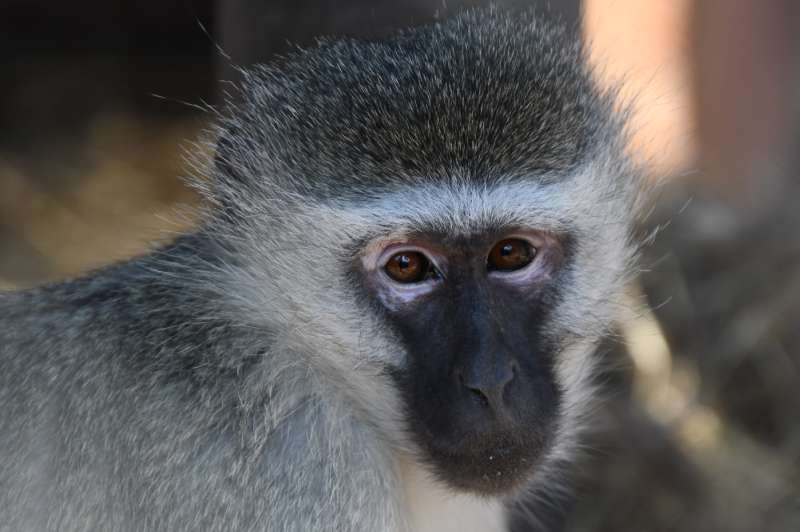Vervet Monkeys

Vervet monkeys are highly social and intelligent animals, living in well-organised troops that can include dozens of individuals. These troops are matriarchal, with females generally remaining in the same group for life, while males may move between groups. Vervets are known for their complex vocalisations, which they use to communicate with each other about the presence of predators and food sources. Their ability to adapt to various environments has allowed them to coexist with humans, though this often leads to conflicts, particularly in areas where their natural habitats have been encroached upon. Despite their adaptability, the survival of vervet monkeys in the wild depends on the balance between conservation efforts and minimising human-wildlife conflict.
Scientific Name: Chlorocebus pygerythrus
- Habitat: Vervet monkeys are adaptable and can live in a variety of woodland, savanna, and forest habitats across sub-Saharan Africa. They are also found in rural and urban areas due to their adaptable nature.
- Diet: Omnivorous, feeding on a diet that includes fruits, leaves, seeds, and occasionally small vertebrates and insects.
- Physical Characteristics: Vervet monkeys have silver-gray bodies with a greenish tinge, black faces surrounded by white fur, and long tails. Adult males are larger than females, with males averaging around 5.5 kg (12 lbs) and females about 4 kg (8.8 lbs).
- Lifespan: They can live up to 24 years in captivity, while their lifespan in the wild is typically shorter.
- Reproduction: Females reach sexual maturity at about 2.5 years, and males at about 4 years. The gestation period is about 165 days, after which a single infant is usually born.
- Conservation Status: Listed as Least Concern by the IUCN, vervet monkeys are widespread and common, though they face threats from habitat destruction, hunting, and pet trade.
Vervet Monkeys at Chipangali

Nomsa
Species: Vervet Monkey
Age on Arrival: Approx. 2 years
Arrival Date: 27 May 2021
Sex: Female
Nomsa’s Story: Nomsa’s journey from the Honde Valley, where monkeys are often hunted, to Chipangali is a tale of survival and refuge. The loss of Jack, her companion, and her integration with Finn and Mowgli underscore the sanctuary’s role as a sanctuary for those in need, offering a second chance at family and companionship.

Finn
Species: Vervet Monkey
Age on Arrival: Born at Chipangali
Arrival Date: 15 November 2018
Sex: Female
Finn’s Story: Finn’s entry into the world was fraught with challenges, as her mother, Paris, struggled with the new demands of motherhood. Her rescue and subsequent nurturing by the sanctuary staff highlight Chipangali’s unwavering commitment to the vulnerable, ensuring even the smallest among them receives the care needed to thrive.

Reigen
Species: Vervet Monkey
Age on Arrival: Born at Chipangali
Arrival Date: 17 November 2016
Sex: Female
Reigen’s Story: Born to Victor and Dansa, Reigen represents the next generation of Chipangali’s vervet monkey troop, embodying the sanctuary’s ongoing legacy of care and conservation. Her birth marks a continuation of the sanctuary’s efforts to maintain natural social structures and ensure the welfare and continuity of its primate inhabitants.

Dansa
Species: Vervet Monkey
Age on Arrival: Approx. 4 months
Arrival Date: 20 January 2012
Sex: Male
Dansa’s Story: Dansa’s tale, beginning with loss as he sat beside his deceased mother, transitions into one of healing and joy within Chipangali’s embrace. His name, a tribute to his spirited nature, reflects the sanctuary’s commitment to nurturing the individual spirits of those in its care, fostering a vibrant community where each can thrive.

Victor
Species: Vervet Monkey
Age on Arrival: Approx. 10 days
Arrival Date: 19 January 2011
Sex: Female
Victor’s Story: Victor’s survival, clinging to her drowned mother, is a testament to the fragile line between life and death in the wild. Her resilience, nurtured by the compassionate care at Chipangali, blossomed into motherhood, enriched by the adoption of Cupid. Her story is one of hope, showcasing the sanctuary’s vital role in weaving new beginnings from the threads of tragedy.

Felix
Species: Vervet Monkey
Age on Arrival: 1 year
Arrival Date: 8 December 2021
Sex: Male
Felix’s Story: Felix’s journey from a mischievous troop causing chaos at an airport to a beloved member of Chipangali’s primate family showcases the sanctuary’s dedication to providing second chances. His integration reflects the ongoing efforts to balance the needs of wildlife with the realities of human encroachment, embodying the sanctuary’s mission of harmony and cohabitation.

Honey
Species: Vervet Monkey
Age on Arrival: 18 Months
Arrival Date: 26 January 2011
Sex: Female
Honey’s Story: Honey, once an ex-pet struggling to find her place among her own kind, illustrates the complex journey of social integration within the sanctuary’s vervet monkey troop. Her affinity for Cupid and Felix highlights the individual personalities and preferences that Chipangali nurtures, ensuring each animal finds companionship and a sense of belonging within the sanctuary’s diverse community.

Cupid
Species: Vervet Monkey
Age on Arrival: 8 weeks
Arrival Date: 29 December 2015
Sex: Male
Cupid’s Story: This is a poignant reminder of the fragility of life in the wild. After his mother fell victim to a farmer’s bullet, he found not just refuge but also a new family at Chipangali. Raised alongside Decklyn by the nurturing Victor, Cupid’s tale underscores the sanctuary’s capacity for love and the unexpected bonds that form across species lines, offering a glimmer of hope amidst loss.

Jasper
Species: Vervet Monkey
Age on Arrival: 6 weeks
Arrival Date: 11 January 2022
Sex: Male
Jasper’s Story: Jasper’s journey from distress to safety encapsulates the sanctuary’s pivotal role in addressing the challenges faced by wildlife in conflict zones. Rejected by his mother amidst the chaos of capture, he found solace and a second chance at family life at Chipangali. His story, from vulnerable infant to thriving youngster, underscores the sanctuary’s commitment to providing a nurturing environment for all under its care.
Get Involved!

